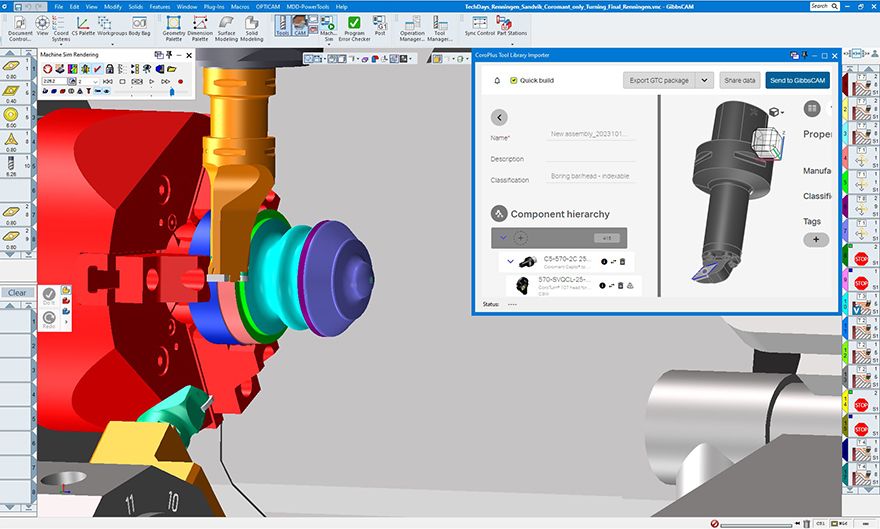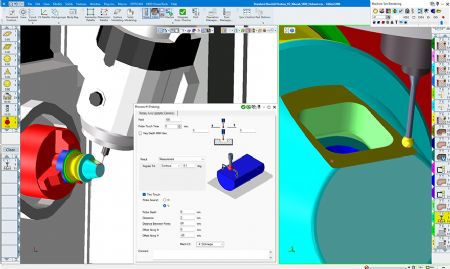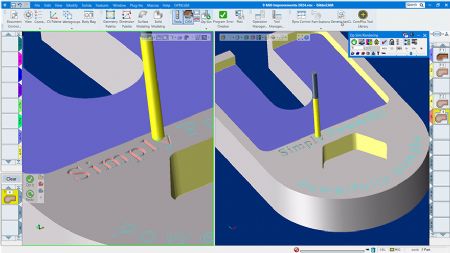 The integration of the CoroPlus Tool Library allows users to define tool assemblies and relevant cutting conditions and import the data directly into GibbsCAMGibbsCAM
The integration of the CoroPlus Tool Library allows users to define tool assemblies and relevant cutting conditions and import the data directly into GibbsCAMGibbsCAM, a leading CAD/CAM innovator in the production machining industry, has announced a new software release. GibbsCAM 2024 continues to boost end-user productivity for programming advanced machining centres, underpinning the GibbsCAM promise of ‘Powerfully simple, simply powerful’.
GibbsCAM 2024 features a number of significant enhancements to core strengths while bringing a stronger emphasis on digital connectivity. Version 2024 unlocks the power of
Sandvik Coromant through a direct integration with the CoroPlus Tool Library, providing access to the right cutting tool for your specific operation and offering instant cutting data recommendations. It provides up-to-date cutting tool data, 3-D models of cutting tools and holders, and essential information to make informed decisions for optimised manufacturing processes.
All data is verified and adheres to the ISO:13399 international standard for cutting tool data representation and exchange. The cloud-based nature of the tool library means that users of GibbsCAM 2024 can access data from anywhere with an internet connection, making it invaluable for organisations implementing company standards, or users who work remotely or across multiple locations.
Tobias Unosson, product manager at Sandvik Coromant, said the manufacturing sector is undergoing a transformation brought on by the marriage of digital and physical. “Sandvik has been in business for more than 160 years and in the tooling business for over 80 years. Selecting tools and methods with the help of proven data deliver higher quality parts, and reduce costs, waste, and energy use, all for the benefit of the end user.”
Post-processor configuration optionsEfficiency remains a primary focus, with the introduction of new post-processor configuration options for setting standard and custom post defaults, including support for TCP or rotary clamps. Furthermore, a new tool to streamline the setup of the CAM environment now enables editing and restriction of work fixture offsets. GibbsCAM 2024 supports multiple fixture stacking, and now unused fixtures can be retained on the machine for simulation and collision checking purposes.
 Pictured right: generic probing now supports rotary part alignment and positioning
Pictured right: generic probing now supports rotary part alignment and positioningThe licensing for version 2024 now replaces the historic CLM technology. This will simplify software deployment and provide more user flexibility for moving licenses as well as enable cloud capabilities in future versions.
Working with CAD data is also easier. Users can interrogate virtual points for dimensioning part geometry such as edge mid points, end points, intersection, circle centre, and circle quadrants directly from the 3-D model. A newly introduced visualisation tool can map the curvature and the relevant taper/draft angle directly onto the 3-D model. This is particularly useful tool for analysing the minimum tooling diameter required to cut a part since it negates the need to pull extra reference geometry.
Alongside many other enhancements, generic probing now supports rotary part alignment and positioning. Selecting only the rotary axis, clearance, and shifting parameters will drive the system to probe the surface and calculate the part rotation alignment.
GibbsCAM 2024 improves the flexibility of form tools in milling processes. Users can now choose how to drive the tool — using the ‘Real’ profile option which uses the exact cutting tool profile, or the ‘Monotonic’ profile which will disable any toolpath that uses the tool undercut form. For 3-D solid-form tools, another option for nominal parameters will only use the major diameter and tip radius for toolpath calculation according to tool manufacturer recommendations, while using the 3-D form tool for simulation.
In addition, second generation B-type inserts are now supported for Sandvik Coromant’s PrimeTurning. This tool has a larger tip radius that can cut deeper and remove material faster.
 Pictured left: variable-depth engraving is greatly improved when using complex fonts with tapered tooling and corner ramping
Pictured left: variable-depth engraving is greatly improved when using complex fonts with tapered tooling and corner rampingA new mill cutoff process for mill-turn machines and bar-fed mills now supports perpendicular cutting with an end mill, or parallel cutting with a side mill or slitting saw.
More-efficient toolpathRest machining has been improved when contouring and pocketing strategies are used together with ‘material only’ active now creates a more-efficient toolpath with reduced air cuts. Other contour improvements include smoother ramping that generates a continuous contour wherever possible instead of multiple ramping lead in and lead out movements.
Also new to GibbsCAM 2024, variable-depth engraving greatly improves the use of complex fonts with tapered tooling and corner ramping. In addition, selectable alignment options are added to control the starting position of operations using a rotary axis. Users can override the default singularity rules, which is useful for keeping the toolpath within machine limits (frequently Y-axis) or machining on the opposite side of a mill/turn part.
New five-axis features include an optimised step over feature for finishing walls and cylindrical or conical floors that creates a better, more consistent surface finish. New geodesic operations perform straight cuts on end boundaries and improve hole filling to prevent the tool dropping down into open cavities.
Other improvements include user-defined tool orientation on lead in and lead out movements, and linked entry feed distance. Multi-axis machining enhancements include better management of 3-D containments, improved point distribution, ramp offset for the first pass on roughing cycles, user defined start points for finishing, and tool tilting during helix entries.
Discussing the new release, GibbsCAM president Thorsten Strauß, said: “The launch of GibbsCAM 2024 is an exciting moment for us, our partners, and our customers. It represents a full-year development cycle that includes a data-driven mix of product innovation and customer-driven enhancements. We know that continuing to leverage Sandvik’s cutting knowledge and expertise will benefit our customers and enable them to produce products more efficiently than ever before.”